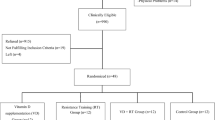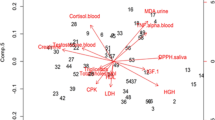Abstract
Purpose
Zataria is a plant with anti-inflammatory properties, which has been used for the treatment of many diseases. This study investigated the effect of different intensities of circuit resistance training and Zataria supplementation on plasma retinol-binding protein-4 (RBP-4) and tumor necrosis factor-α (TNF-α) in postmenopausal women.
Methods
Seventy-two postmenopausal women were divided on randomized order into six groups: Control (McGinley and Bishop in J Appl Physiol 121(6):1290–1305, 2016), Training 35% (T35%), Training 55% (T55%), Zataria (Özgünen et al. in Scand J Med Sci Sports 20:140–147, 2010), Zataria/Training 35% (ZT35%), and Zataria/Training 55% (ZT55%). Resistance training program included 12 exercise stations (each: 30 s, intensity: 35% and 55% of 1-RM) for 8 weeks (3 sessions/week). Daily (500 mg) Zataria was used after breakfast by participants in ZG, ZT35%, and ZT55% groups. Blood samples were taken 48 h before and after the first and last sessions of training.
Results
After the training period the percentage of body fat decreased significantly (P < 0.001) in all trained groups, whereas muscle mass increased significantly (P < 0.01) only in T55% and ZT55% groups. A significant decrease was observed for RBP-4 values (P < 0.05) after training in all groups except for ZG and CG. Also, RBP-4 was significantly lower (P < 0.05) in all groups as compared to CG at the post-test except for ZG. Moreover, significantly lower values (P < 0.05) were found in T55%, ZT35%, and ZT55% as compared to ZG in post-intervention. TNF-α values decreased significantly (P < 0.05) at the post-test as compared to pre-intervention in ZT35% and ZT55%. Also, TNF-α was significantly lower (P < 0.05) in ZT55% compared to CG and T35% in post-test
Conclusions
The results demonstrate clearly that in postmenopausal women, circuit resistance training both at low and moderate intensities cause a greater reduction in RBP-4 and TNF-α when Zataria is supplemented in the diet during training.


Similar content being viewed by others
Change history
25 November 2019
Unfortunately, the 4th author name was incorrectly published in the original publication. The complete correct name should read as follows.
References
Zuo H, Shi Z, Hu X, Wu M, Guo Z, Hussain A (2009) Prevalence of metabolic syndrome and factors associated with its components in Chinese adults. Metabolism 58(8):1102–1108
Stefanska A, Sypniewska G, Ponikowska I, Cwiklinska-Jurkowska M (2012) Association of follicle-stimulating hormone and sex hormone binding globulin with the metabolic syndrome in postmenopausal women. Clin Biochem 45(9):703–706
Stachowiak G, Pertyński T, Pertyńska-Marczewska M (2015) Metabolic disorders in menopause. Menopause Rev 14(1):59
Haider DG, Schindler K, Prager G, Bohdjalian A, Luger A, Wolzt M et al (2007) Serum retinol-binding protein 4 is reduced after weight loss in morbidly obese subjects. J Clin Endocrinol Metab 92(3):1168–1171
Jia W, Wu H, Bao Y, Lu J, Wang C, Zhu J et al. Association of Serum retinol binding protein 4 and visceral adiposity in chinese diabetes and non-diabetes subjects. Diabetes. 2007;56
Bukovská A, Cikoš Š, Juhás Š, Il’ková G, Rehák P, Koppel J (2007) Effects of a combination of thyme and oregano essential oils on TNBS-induced colitis in mice. Med Inflamm
Cawthorn WP, Sethi JK (2008) TNF-α and adipocyte biology. FEBS Lett 582(1):117–131
Olszanecka-Glinianowicz M, Chudek J, Kocełak P, Szromek A, Zahorska-Markiewicz B (2011) Body fat changes and activity of tumor necrosis factor α system—a 5-year follow-up study. Metabolism 60(4):531–536
Lujan HL, DiCarlo SE (2013) Physical activity, by enhancing parasympathetic tone and activating the cholinergic anti-inflammatory pathway, is a therapeutic strategy to restrain chronic inflammation and prevent many chronic diseases. Med Hypotheses 80(5):548–552
Saremi A, Gheraati M (2010) The Effect of resistance training on serum myostatin level and insulin resistance in obese-overweight men
Taaffe D, Pruitt L, Pyka G, Guido D, Marcus R (1996) Comparative effects of high-and low-intensity resistance training on thigh muscle strength, fiber area, and tissue composition in elderly women. Clin Physiol 16(4):381–392
Karaarslan S, Büyükyazi G, Taneli F, Ulman C, Tikiz C, GÜMÜŞER G et al (2010) Effects of different intensity resistance exercise programs on bone turnover markers, osteoprotegerin and receptor activator of nuclear factor kappa β ligand in post-menopausal women. Turkiye Klinikleri J Med Sci 30(1):123–134
Imayama I, Alfano CM, Kong A, Foster-Schubert KE, Bain CE, Xiao L et al (2011) Dietary weight loss and exercise interventions effects on quality of life in overweight/obese postmenopausal women: a randomized controlled trial. Int J Behav Nutr Phys Act 8(1):118
Mohammadi A, Gholamhoseinian A, Fallah H (2014) Zataria multiflora increases insulin sensitivity and PPARγ gene expression in high fructose fed insulin resistant rats. Iran J Basic Med Sci 17(4):263
Anvari M, Dashti M, Zeinali F, Hosseini-Bioki S (2011) The effect of thyme (Zataria multiflora Boiss.) decoction on pregnancy in rats. J Med Plants 2(38):19–25
Sodouri M, Alavi NM, Fathizadeh N, Taghizadeh M, Azarbad Z, Memarzadeh M (2013) Effects of Zataria multi-flora, Shirazi thyme, on the severity of premenstrual syndrome. Nurs Midwifery Stud 2(4):57
Ocaña A, Reglero G (2012) Effects of thyme extract oils (from Thymus vulgaris, Thymus zygis, and Thymus hyemalis) on cytokine production and gene expression of oxLDL-stimulated THP-1-macrophages. J Obes
Tayebi SM, Hasannezhad P, Saeidi A, Fadaei MR (2016) Intense circuit resistance training along with Zataria multiflora supplementation reduced plasma retinol binding protein-4 and tumor necrosis factor-α in postmenopausal females. Jundishapur J Nat Pharm Prod e38578 (in press)
Ghanbari-Niaki A, Saeidi A, Ahmadian M, Gharahcholo L, Naghavi N, Fazelzadeh M et al (2018) The combination of exercise training and Zataria multiflora supplementation increase serum irisin levels in postmenopausal women. Integr Med Res 7(1):44–52
McGinley C, Bishop DJ (2016) Influence of training intensity on adaptations in acid/base transport proteins, muscle buffer capacity, and repeated-sprint ability in active men. J Appl Physiol 121(6):1290–1305
Özgünen K, Kurdak S, Maughan R, Zeren C, Korkmaz S, Yazιcι Z et al (2010) Effect of hot environmental conditions on physical activity patterns and temperature response of football players. Scand J Med Sci Sports 20:140–147
Saei-Dehkordi SS, Tajik H, Moradi M, Khalighi-Sigaroodi F (2010) Chemical composition of essential oils in Zataria multiflora Boiss. From different parts of Iran and their radical scavenging and antimicrobial activity. Food Chem Toxicol 48(6):1562–1567
Ghanbari–Niaki A, Saeidi A, Aliakbari-Beydokhti M, Ardeshiri S, Kolahdouzi S, Chaichi MJ et al (2015) Effects of circuit resistance training with crocus sativus (saffron) supplementation on plasma viscosity and fibrinogen. Ann Appl Sport Sci 3(2):1–10
Petersen AMW, Pedersen BK (2005) The anti-inflammatory effect of exercise. J Appl Physiol 98(4):1154–1162
Bryner RW, Ullrich IH, Sauers J, Donley D, Hornsby G, Kolar M et al (1999) Effects of resistance vs. aerobic training combined with an 800 calorie liquid diet on lean body mass and resting metabolic rate. J Am Coll Nutr 18(2):115–121
Prabhakaran B, Dowling EA, Branch JD, Swain DP, Leutholtz BC (1999) Effect of 14 weeks of resistance training on lipid profile and body fat percentage in premenopausal women. Br J Sports Med 33(3):190–195
Ghahramanloo E, Midgley AW, Bentley DJ (2009) The effect of concurrent training on blood lipid profile and anthropometrical characteristics of previously untrained men. J Phys Act Health 6(6):760–766
Souri R, Vahabi K, Shabkhiz F (2011) Effects of interval aerobic training on serum RBP4 and insulin resistance in type 2 diabetic patients. Iran J Diabetes Metabol 10(4):388–397
Choi K, Kim T, Yoo H, Lee K, Cho G, Hwang T et al (2009) Effect of exercise training on A-FABP, lipocalin-2 and RBP4 levels in obese women. Clin Endocrinol 70(4):569–574
Graham TE, Yang Q, Blüher M, Hammarstedt A, Ciaraldi TP, Henry RR et al (2006) Retinol-binding protein 4 and insulin resistance in lean, obese, and diabetic subjects. N Engl J Med 354(24):2552–2563
Okazaki K, Kawazoe K, Takaishi Y (2002) Human platelet aggregation inhibitors from thyme (Thymus vulgaris L.). Phytother Res 16(4):398–399
Saghizadeh M, Ong JM, Garvey WT, Henry RR, Kern PA (1996) The expression of TNF alpha by human muscle. Relationship to insulin resistance. J Clin Investig 97(4):1111–1116
Hotamisligil GS, Spiegelman BM (1994) Tumor necrosis factor α: a key component of the obesity-diabetes link. Diabetes 43(11):1271–1278
Bouskela E (2010) Effects of resistance training on cytokines. Int J Sports Med 31:441450
Fiers W (1991) Tumor necrosis factor characterization at the molecular, cellular and in vivo level. FEBS Lett 285(2):199–212
Keller C, Keller P, Giralt M, Hidalgo J, Pedersen BK (2004) Exercise normalises overexpression of TNF-α in knockout mice. Biochem Biophys Res Commun 321(1):179–182
Balducci S, Zanuso S, Nicolucci A, Fernando F, Cavallo S, Cardelli P et al (2010) Anti-inflammatory effect of exercise training in subjects with type 2 diabetes and the metabolic syndrome is dependent on exercise modalities and independent of weight loss. Nutr Metab Cardiovasc Dis 20(8):608–617
Pollock ML, Franklin BA, Balady GJ, Chaitman BL, Fleg JL, Fletcher B et al (2000) Resistance exercise in individuals with and without cardiovascular disease: benefits, rationale, safety, and prescription an advisory from the committee on exercise, rehabilitation, and prevention, council on clinical cardiology. Am Heart Assoc Circ 101(7):828–833
Lixandru Ba -E, Drăcea N, Dragomirescu CC, Drăgulescu E, Coldea IL, Anton L et al (2010) Antimicrobial activity of plant essential oils against bacterial and fungal species involved in food poisoning and/or food decay. Roum Arch Microbiol Immunol 69(4):224–230
Author information
Authors and Affiliations
Corresponding author
Ethics declarations
Conflict of interest
The authors declare that they have no conflict of interest.
Ethical approval
The study was approved under the procedures of the local Ethics Committee. All procedures were carried out in line with the Declaration of Helsinki.
Informed consent
All participants gave written informed consent before participating in the study.
Additional information
Publisher’s Note
Springer Nature remains neutral with regard to jurisdictional claims in published maps and institutional affiliations.
Rights and permissions
About this article
Cite this article
Tayebi, S.M., Saeidi, A., Fashi, M. et al. Plasma retinol-binding protein-4 and tumor necrosis factor-α are reduced in postmenopausal women after combination of different intensities of circuit resistance training and Zataria supplementation. Sport Sci Health 15, 551–558 (2019). https://doi.org/10.1007/s11332-019-00544-2
Received:
Accepted:
Published:
Issue Date:
DOI: https://doi.org/10.1007/s11332-019-00544-2




